SNVS265C December 2003 – January 2016 LM5025
PRODUCTION DATA.
- 1 Features
- 2 Applications
- 3 Description
- 4 Revision History
- 5 Pin Configuration and Functions
- 6 Specifications
- 7 Detailed Description
- 8 Application and Implementation
- 9 Power Supply Recommendations
- 10Layout
- 11Device and Documentation Support
- 12Mechanical, Packaging, and Orderable Information
6 Specifications
6.1 Absolute Maximum Ratings
over operating free-air temperature range (unless otherwise noted)(1)| MIN | MAX | UNIT | ||
|---|---|---|---|---|
| Input voltage | VIN to GND | –0.3 | 100 | V |
| VCC to GND | –0.3 | 16 | ||
| CS1, CS2 to GND | –0.3 | 1 | V | |
| All other inputs to GND | –0.3 | 7 | V | |
| Junction temperature, TJ | 150 | °C | ||
| Storage temperature, Tstg | –55 | 150 | °C | |
(1) Stresses beyond those listed under Absolute Maximum Ratings may cause permanent damage to the device. These are stress ratings only, which do not imply functional operation of the device at these or any other conditions beyond those indicated under Recommended Operating Conditions. Exposure to absolute-maximum-rated conditions for extended periods may affect device reliability.
6.2 ESD Ratings
| VALUE | UNIT | |||
|---|---|---|---|---|
| V(ESD) | Electrostatic discharge(1) | Human-body model (HBM), per ANSI/ESDA/JEDEC JS01(2) | ±2000 | V |
| Charged-device model (CDM), per JEDEC specification JESD22-C101(3) | ±500 | |||
(1) For detailed information on soldering plastic TSSOP and WSON packages, refer to the Packaging Data Book.
(2) JEDEC document JEP155 states that 500-V HBM allows safe manufacturing with a standard ESD control process.
(3) JEDEC document JEP157 states that 250-V CDM allows safe manufacturing with a standard ESD control process.
6.3 Recommended Operating Conditions
over operating free-air temperature range (unless otherwise noted)| MIN | NOM | MAX | UNIT | ||
|---|---|---|---|---|---|
| VIN voltage | 13 | 90 | V | ||
| External voltage applied to VCC | 8 | 15 | V | ||
| Operating junction temperature | –40 | 125 | °C | ||
6.4 Thermal Information
| THERMAL METRIC(1) | LM5025 | UNIT | ||
|---|---|---|---|---|
| PW (TSSOP) | NHQ (WSON) | |||
| 16-PINS | 16-PINS | |||
| RθJA | Junction-to-ambient thermal resistance | 98.7 | 30 | °C/W |
| RθJC(top) | Junction-to-case (top) thermal resistance | 27.8 | 25.9 | °C/W |
| RθJB | Junction-to-board thermal resistance | 44.3 | 9.3 | °C/W |
| ψJT | Junction-to-top characterization parameter | 1.2 | 0.2 | °C/W |
| ψJB | Junction-to-board characterization parameter | 43.6 | 9.5 | °C/W |
| RθJC(bot) | Junction-to-case (bottom) thermal resistance | — | 2.3 | °C/W |
(1) For more information about traditional and new thermal metrics, see the Semiconductor and IC Package Thermal Metrics application report, SPRA953.
6.5 Electrical Characteristics
Specifications are TJ = 25°C. Unless otherwise specified: VIN = 48 V, VCC = 10 V, RT = 31.3 kΩ, RSET = 27.4 kΩ(1)| PARAMETER | TEST CONDITIONS | MIN | TYP | MAX | UNIT | ||
|---|---|---|---|---|---|---|---|
| STARTUP REGULATOR | |||||||
| VCC Reg | VCC regulation | No load | TJ = 25°C | 7.6 | V | ||
| TJ = –40°C to 125°C | 7.3 | 7.9 | |||||
| VCC current limit(2) | TJ = 25°C | 25 | mA | ||||
| TJ = –40°C to 125°C | 20 | ||||||
| I-VIN | Startup regulator leakage (external Vcc Supply) | VIN = 100 V | TJ = 25°C | 165 | µA | ||
| TJ = –40°C to 125°C | 500 | ||||||
| Shutdown current (Iin) | UVLO = 0 V | TJ = 25°C | 350 | µA | |||
| TJ = –40°C to 125°C | 450 | ||||||
| VCC SUPPLY | |||||||
| VCC undervoltage lockout voltage (positive going Vcc) | TJ = 25°C | VCC Reg – 120 mV | V | ||||
| TJ = –40°C to 125°C | VCC Reg – 220 mV | ||||||
| VCC undervoltage hysteresis | TJ = 25°C | 1.5 | V | ||||
| TJ = –40°C to 125°C | 1 | 2 | |||||
| VCC supply current (ICC) | Cgate = 0 | TJ = –40°C to 125°C | 4.2 | mA | |||
| REFERENCE SUPPLY | |||||||
| VREF | Ref voltage | IREF = 0 mA | TJ = 25°C | 5 | V | ||
| TJ = –40°C to 125°C | 4.85 | 5.15 | |||||
| Ref voltage regulation | IREF = 0 to 10 mA | TJ = 25°C | 25 | mV | |||
| TJ = –40°C to 125°C | 50 | ||||||
| Ref current limit | TJ = 25°C | 20 | mA | ||||
| TJ = –40°C to 125°C | 10 | ||||||
| CURRENT LIMIT | |||||||
| CS1 Prop | CS1 delay to output | CS1 step from 0 to 0.4 V, Time to onset of OUT transition (90%), Cgate = 0 |
40 | ns | |||
| CS2 Prop | CS2 delay to output | CS2 step from 0 to 0.4 V, Time to onset of OUT transition (90%), Cgate = 0 |
50 | ns | |||
| Leading edge blanking time | 50 | ns | |||||
| Cycle by cycle threshold voltage (CS1) | TJ = 25°C | 0.25 | V | ||||
| TJ = –40°C to 125°C | 0.22 | 0.28 | |||||
| Cycle skip threshold voltage (CS2) | Resets SS capacitor; auto restart | TJ = 25°C | 0.25 | V | |||
| TJ = –40°C to 125°C | 0.22 | 0.28 | |||||
| CS sink impedance (clocked) | ICS = 10 mA | TJ = 25°C | 30 | Ω | |||
| TJ = –40°C to 125°C | 50 | ||||||
| SOFT-START | |||||||
| Soft-start current source normal | TJ = 25°C | 22 | µA | ||||
| TJ = –40°C to 125°C | 17 | 27 | |||||
| Soft-start current source following a CS2 event | TJ = 25°C | 1 | µA | ||||
| TJ = –40°C to 125°C | 0.5 | 1.5 | |||||
| OSCILLATOR | |||||||
| Frequency1 | TJ = 25°C | 180 | 200 | 220 | kHz | ||
| TJ = –40°C to 125°C | 175 | 225 | |||||
| Frequency2 | RT = 10.4 KΩ | TJ = 25°C | 580 | kHz | |||
| TJ = –40°C to 125°C | 500 | 660 | |||||
| Sync frequency | TJ = –40°C to 125°C | 160 | kHz | ||||
| Sync threshold | 2 | V | |||||
| Minimum sync pulse width | TJ = –40°C to 125°C | 100 | ns | ||||
| PWM COMPARATOR | |||||||
| Delay to output | COMP step 5 V to 0 V, Time to onset of OUT_A transition low |
40 | ns | ||||
| Duty cycle | TJ = –40°C to 125°C | 0% | 80% | ||||
| COMP to PWM offset | TJ = 25°C | 1 | V | ||||
| TJ = –40°C to 125°C | 0.7 | 1.3 | |||||
| COMP open circuit voltage | TJ = –40°C to 125°C | 4.3 | 5.9 | V | |||
| COMP short circuit current | COMP = 0 V | TJ = 25°C | 1 | mA | |||
| TJ = –40°C to 125°C | 0.6 | 1.4 | |||||
| VOLT × SECOND CLAMP | |||||||
| Ramp clamp level | Delta RAMP measured from onset of OUT_A to Ramp peak, COMP = 5 V |
TJ = 25°C | 2.5 | V | |||
| TJ = –40°C to 125°C | 2.4 | 2.6 | |||||
| UVLO SHUTDOWN | |||||||
| Undervoltage shutdown threshold | TJ = 25°C | 2.5 | V | ||||
| TJ = –40°C to 125°C | 2.44 | 2.56 | |||||
| Undervoltage shutdown hysteresis | TJ = 25°C | 20 | µA | ||||
| TJ = –40°C to 125°C | 16 | 24 | |||||
| OUTPUT SECTION | |||||||
| OUT_A high saturation | MOS device at Iout = –10 mA | TJ = 25°C | 5 | Ω | |||
| TJ = –40°C to 125°C | 10 | ||||||
| OUT_A low saturation | MOS device at Iout = 10 mA | TJ = 25°C | 6 | Ω | |||
| TJ = –40°C to 125°C | 9 | ||||||
| OUT_B high saturation | MOS device at Iout = –10 mA | TJ = 25°C | 10 | Ω | |||
| TJ = –40°C to 125°C | 20 | ||||||
| OUT_B low saturation | MOS device at Iout = 10 mA | TJ = 25°C | 12 | Ω | |||
| TJ = –40°C to 125°C | 18 | ||||||
| OUTPUT_B peak current sink | Bipolar device at Vcc/2 | 1 | A | ||||
| OUTPUT_A peak current sink | Bipolar device at Vcc/2 | 3 | A | ||||
| OUTPUT_A rise time | Cgate = 2.2 nF | 20 | ns | ||||
| OUTPUT_A fall time | Cgate = 2.2 nF | 15 | ns | ||||
| OUTPUT_B rise time | Cgate = 1 nF | 20 | ns | ||||
| OUTPUT_B fall time | Cgate = 1 nF | 15 | ns | ||||
| OUTPUT TIMING CONTROL | |||||||
| Overlap time | RSET = 38 kΩ connected to GND, 50% to 50% transitions | TJ = 25°C | 105 | ns | |||
| TJ = –40°C to 125°C | 75 | 135 | |||||
| Deadtime | RSET = 29.5 kΩ connected to REF, 50% to 50% transitions | TJ = 25°C | 105 | ns | |||
| TJ = –40°C to 125°C | 75 | 135 | |||||
| THERMAL SHUTDOWN | |||||||
| TSD | Thermal shutdown threshold | 165 | °C | ||||
| Thermal shutdown hysteresis | 25 | °C | |||||
(1) All electrical characteristics having room temperature limits are tested during production with TA = TJ = 25°C. All hot and cold limits are specified by correlating the electrical characteristics to process and temperature variations and applying statistical process control.
(2) Device thermal limitations may limit usable range.
6.6 Typical Characteristics
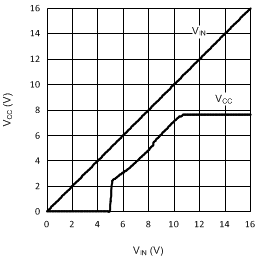 Figure 1. VCC Regulator Start-Up Characteristics, VCC vs Vin
Figure 1. VCC Regulator Start-Up Characteristics, VCC vs Vin
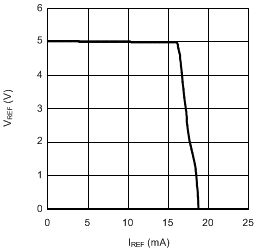 Figure 3. VREF vs IREF
Figure 3. VREF vs IREF
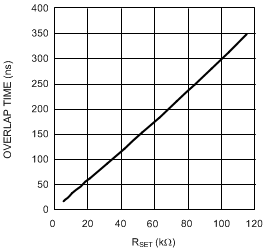 Figure 5. Overlap Time vs RSET
Figure 5. Overlap Time vs RSET
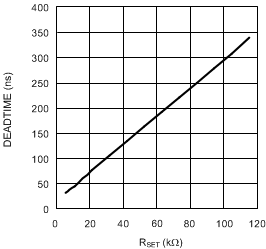 Figure 7. Dead Time vs RSET
Figure 7. Dead Time vs RSET
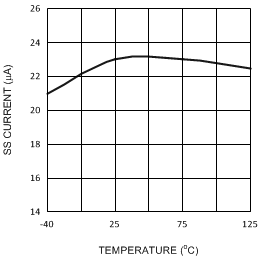 Figure 9. SS Pin Current vs Temperature
Figure 9. SS Pin Current vs Temperature
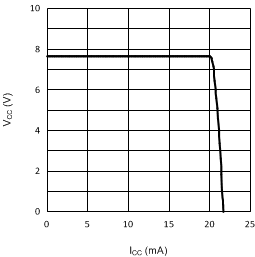 Figure 2. VCC vs ICC
Figure 2. VCC vs ICC
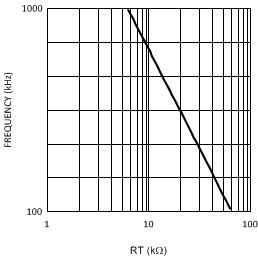 Figure 4. Oscillator Frequency vs RT
Figure 4. Oscillator Frequency vs RT
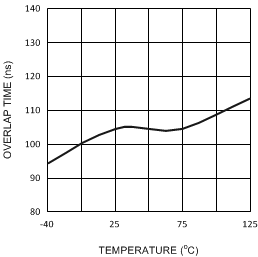 Figure 6. Overlap Time vs Temperature RSET = 38 K
Figure 6. Overlap Time vs Temperature RSET = 38 K
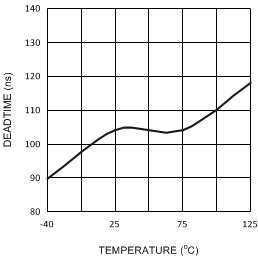 Figure 8. Dead Time vs Temperature RSET = 29.5 K
Figure 8. Dead Time vs Temperature RSET = 29.5 K